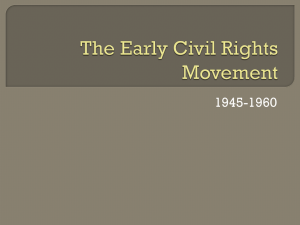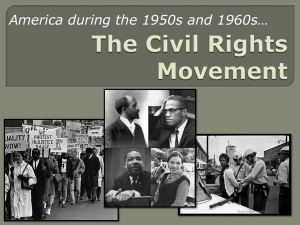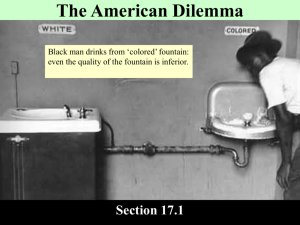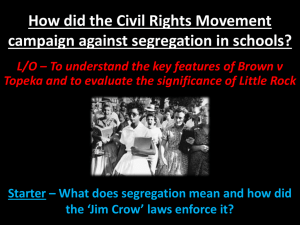Civil Rights Reading Assessment Review_2
advertisement
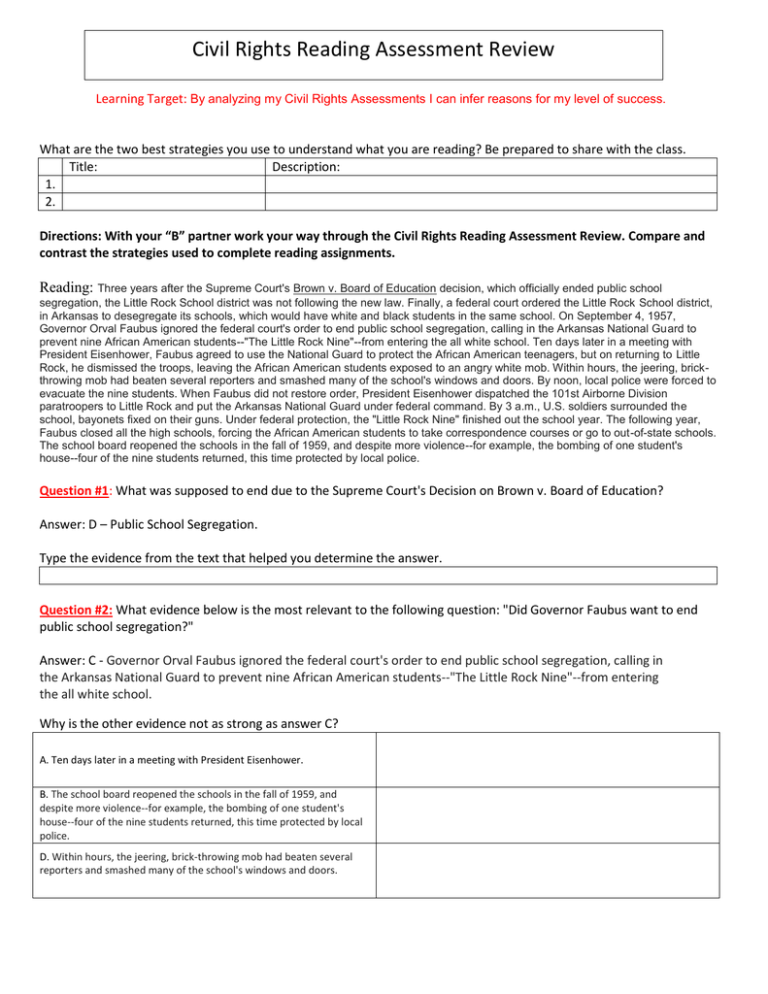
Civil Rights Reading Assessment Review Learning Target: By analyzing my Civil Rights Assessments I can infer reasons for my level of success. What are the two best strategies you use to understand what you are reading? Be prepared to share with the class. Title: Description: 1. 2. Directions: With your “B” partner work your way through the Civil Rights Reading Assessment Review. Compare and contrast the strategies used to complete reading assignments. Reading: Three years after the Supreme Court's Brown v. Board of Education decision, which officially ended public school segregation, the Little Rock School district was not following the new law. Finally, a federal court ordered the Little Rock School district, in Arkansas to desegregate its schools, which would have white and black students in the same school. On September 4, 1957, Governor Orval Faubus ignored the federal court's order to end public school segregation, calling in the Arkansas National Guard to prevent nine African American students--"The Little Rock Nine"--from entering the all white school. Ten days later in a meeting with President Eisenhower, Faubus agreed to use the National Guard to protect the African American teenagers, but on returning to Little Rock, he dismissed the troops, leaving the African American students exposed to an angry white mob. Within hours, the jeering, brickthrowing mob had beaten several reporters and smashed many of the school's windows and doors. By noon, local police were forced to evacuate the nine students. When Faubus did not restore order, President Eisenhower dispatched the 101st Airborne Division paratroopers to Little Rock and put the Arkansas National Guard under federal command. By 3 a.m., U.S. soldiers surrounded the school, bayonets fixed on their guns. Under federal protection, the "Little Rock Nine" finished out the school year. The following year, Faubus closed all the high schools, forcing the African American students to take correspondence courses or go to out-of-state schools. The school board reopened the schools in the fall of 1959, and despite more violence--for example, the bombing of one student's house--four of the nine students returned, this time protected by local police. Question #1: What was supposed to end due to the Supreme Court's Decision on Brown v. Board of Education? Answer: D – Public School Segregation. Type the evidence from the text that helped you determine the answer. Question #2: What evidence below is the most relevant to the following question: "Did Governor Faubus want to end public school segregation?" Answer: C - Governor Orval Faubus ignored the federal court's order to end public school segregation, calling in the Arkansas National Guard to prevent nine African American students--"The Little Rock Nine"--from entering the all white school. Why is the other evidence not as strong as answer C? A. Ten days later in a meeting with President Eisenhower. B. The school board reopened the schools in the fall of 1959, and despite more violence--for example, the bombing of one student's house--four of the nine students returned, this time protected by local police. D. Within hours, the jeering, brick-throwing mob had beaten several reporters and smashed many of the school's windows and doors. Question #3: Which of the following is the weakest piece of evidence one could use to support the claim that the federal government wanted to end Segregation? Answer: C – Within hours, the jeering, brick-throwing mob had beaten several reporters and smashed many of the school’s windows and doors. Why is this the weakest piece of evidence to support the claim that the federal government wanted to end Segregation? Question #4: What is the main idea of the article?" Answer: B – The Governor and citizens of Arkansas did not accept the Supreme Court’s decision to desegregate the schools. Give 3 pieces of evidence that supports the main idea of this reading. Evidence: 1. 2. 3. Question #5: What evidence from the article does not directly support the main idea?" Answer: “The Supreme Court’s Brown v. Board of Education decision, which officially ended public-school segregation.” How does this evidence not support the main idea of the article, which was “The Governor and citizens of Arkansas did not accept the Supreme Court’s decision to desegregate the schools?”

